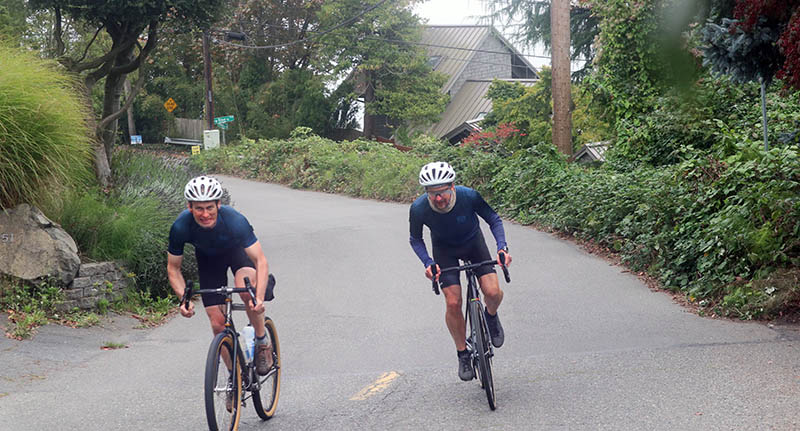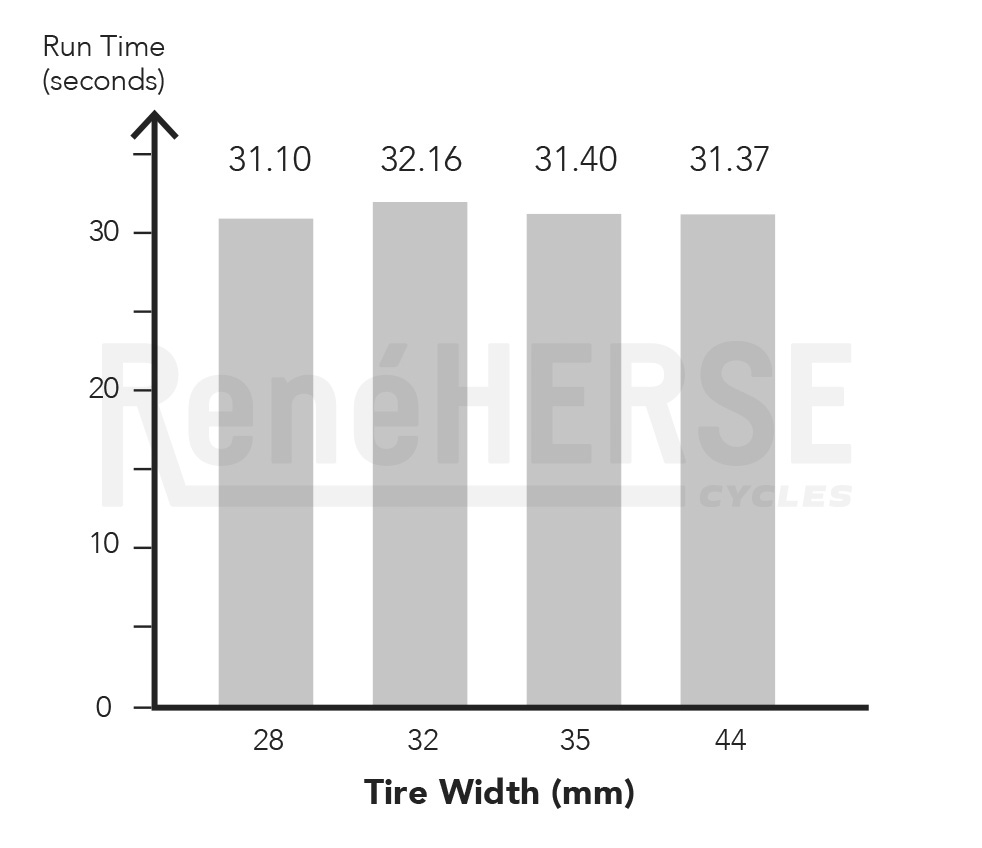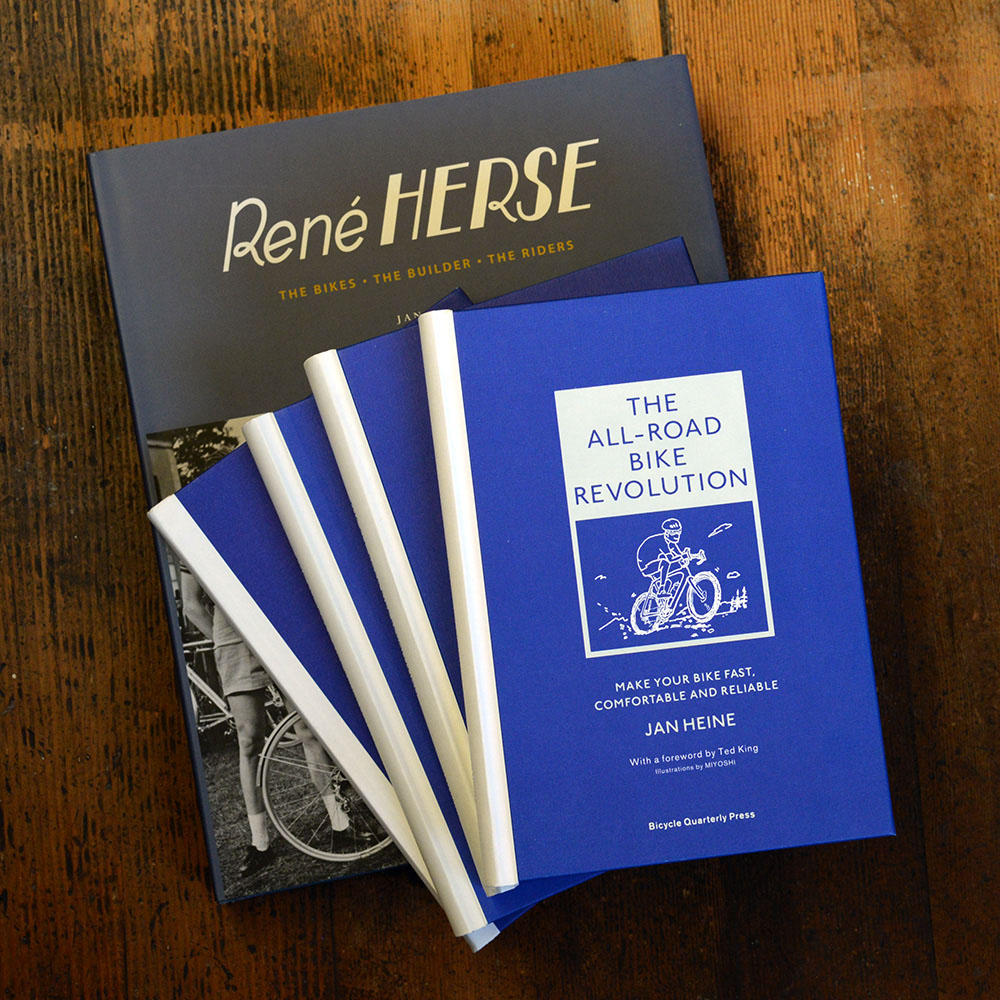What Makes a Bike Fast?
It used to be easy: If you wanted a fast bike, you chose a racing bike. End of story. And what made a racing bike special were first and foremost the narrow tires. Light weight was a plus, too, and so was the lower, more aero riding position.
Then came the ‘All-Road Bike Revolution,’ and suddenly things aren’t so simple any longer. When we recently tested OPEN’s new MIN.D. racing bike (right), it was a great opportunity to look into what really makes a bike fast. So we tested the racer side-by-side with my Firefly all-road bike (left). Carbon vs titanium. 32 mm tires vs 54 mm. Superlight (7.7 kg) vs merely light (9.7 kg). (That’s 17.0 and 21.4 pounds.) Which is faster?
And then we changed the variables: We put narrow tires on the Firefly, added weight to the OPEN. How did this affect their performance? How do you make a bike faster?
Mark and I share the same build, same height, same weight and same power output. We are as close to identical clones as you can get. For this test, we rode (and sprinted) side by side, then switched bikes and repeated. Then switched bikes again… This method allows us to find out quickly if one bike is faster. Wind, temperature, fatigue, and other factors affect us both equally, so if one bike is always ahead, it’s faster. If one rider is always ahead, that rider has a really good day. Even then, we can see whether one bike gives a greater advantage than the other. It’s a very useful test made possible by the fluke of nature that created two riders who are so well-matched.
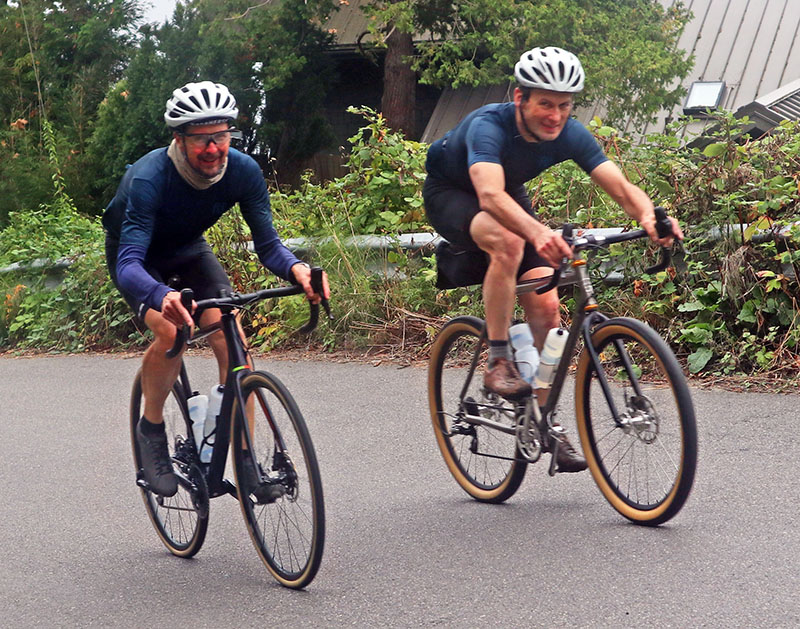
How much faster is a lighter bike?
Bike weight is easy to measure: Just hang your bike from a scale. The 7.7 kg bike on the left is 20% lighter than the 9.7 kg bike on the right. Simple physics tells us that the bike on the left will be faster uphill. The question is: How much faster? Can you feel the 20% difference on the road, as you ride with friends?
The answer is: No. Why? We need to look at bike and rider together. Mark and I each weigh 70 kg. With the rider on board, the OPEN tips the scales at a little over 80 kg. Now the 2 kg weight difference is just 2.5%. And since wind resistance goes up with the square of speed, a 2.5% weight difference translates into just a 1-2% difference in speed. We’ll later see that even if we make the OPEN heavier and the Firefly lighter, it won’t noticeably change their uphill speeds.
This doesn’t mean that weight doesn’t matter: A lighter bike feels different. When you ride out of the saddle, how the bike rocks from side to side depends on how much the bike weighs and where the weight is placed. (Lower is better.) That is why it makes sense to lower the bike’s center of gravity, for example, by placing the water bottles low in the frame.
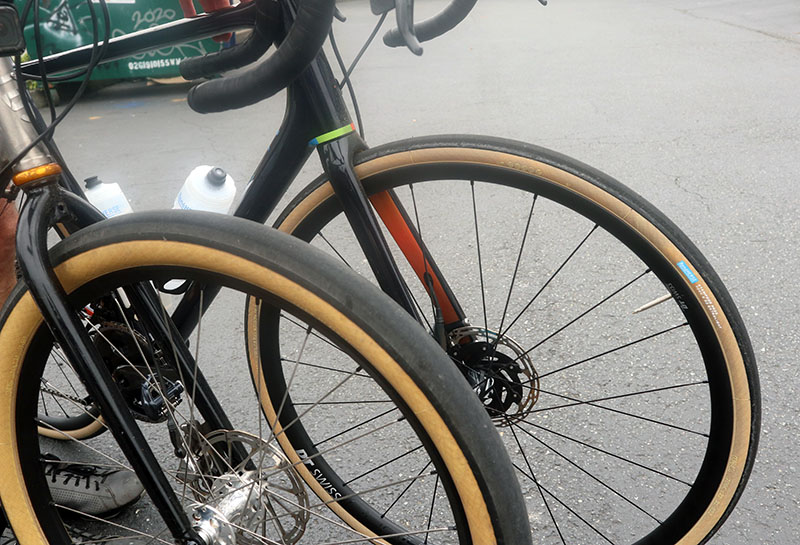
Do lighter wheels accelerate faster?
Physics tells us that lighter wheels ‘spin up’ faster. You sometimes hear that “an ounce saved on the wheels is worth a pound on the frame.” Does rotating weight really make such a big difference?
The OPEN has carbon rims and superlight tires (235 g). The 54 mm tires of the Firefly are very light for such big tires (418 g), but there’s a lot of rubber on a 54 mm tire. Add the aluminum rims, and the Firefly’s heavier wheels account for almost half of the weight difference between the two bikes.
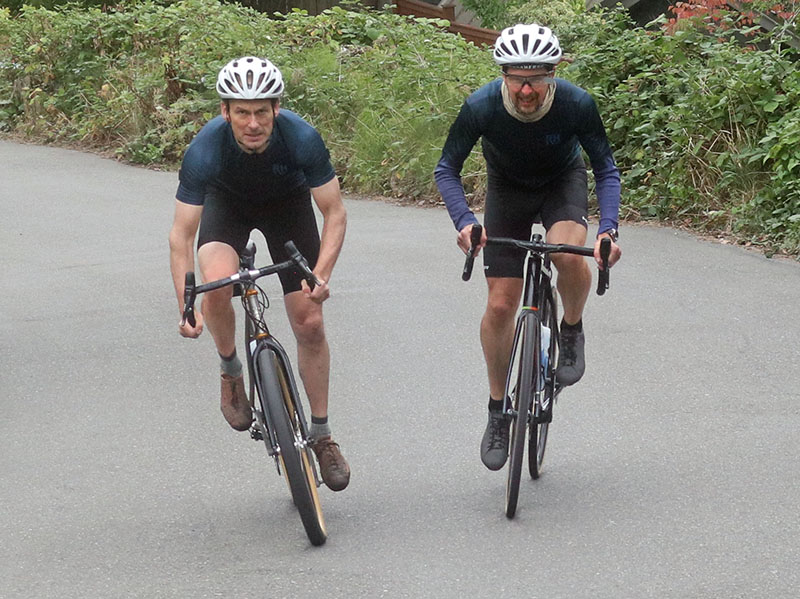
In an uphill sprint, you’d expect the racing bike (OPEN) to leave the all-road bike (Firefly) for dead. To test this, we sprinted, racing up a steep ravine on Seattle’s Magnolia Hill. We repeated this time after time, swapping bikes, until the result was clear: In all-out sprints, the two bikes were evenly matched.
Of course, it could be that some hidden variable – maybe the ‘magic of titanium’ – gives the Firefly an advantage and compensates for its heavier weight and wider tires. How to make sure? Simple: Put narrow (and light) tires on the Firefly, too.
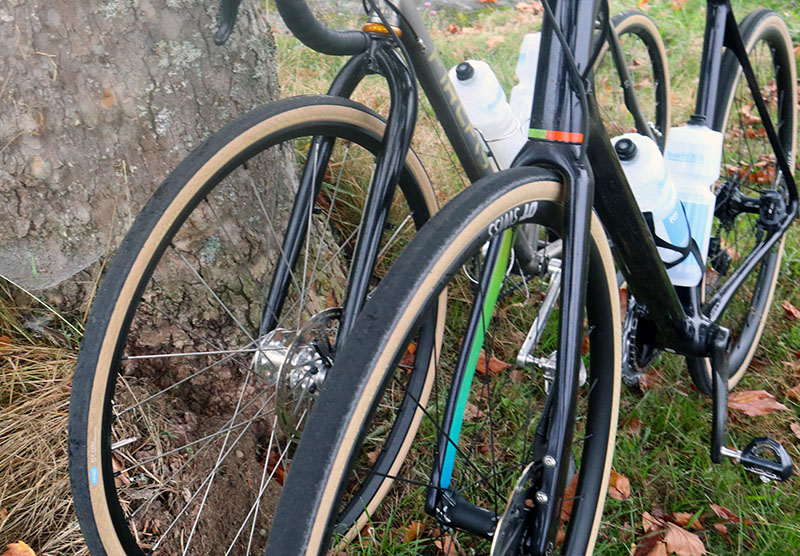
The Rene Herse Elk Pass tires are among the lightest bike tires in the world. They measure 30 mm wide and weigh just 165 g. That makes them 2 mm narrower and 70 g lighter—each!—than the OPEN’s tires. (The Firefly runs smaller 26″ wheels, hence the big weight difference in the tires.)
Now the Firefly’s wheels are actually a little lighter than those of the OPEN. To equalize the weight further, we’re also putting two full water bottles on the OPEN and two empty ones on the Firefly. Now both bikes weigh the same, and the Firefly has the narrower tires and lighter wheels. Before, both bikes were evenly matched. Now, with so much weight and resistance removed, will the Firefly be faster than the OPEN?
The Firefly’s uphill speed is unchanged. It accelerates as fast on the slender 30 mm tires as it did on the big 54 mm rubber. Taking more than a pound off the wheels hasn’t made a noticeable difference.
Why? The simple (and sad) fact is that cyclists don’t have a very high power-to-weight ratio. Even the cheapest economy cars have five times as much horsepower per kilogram (or pound) of weight as a pro bike racer. Cyclists don’t accelerate very quickly, and the weight of the rotating parts doesn’t make a huge difference.
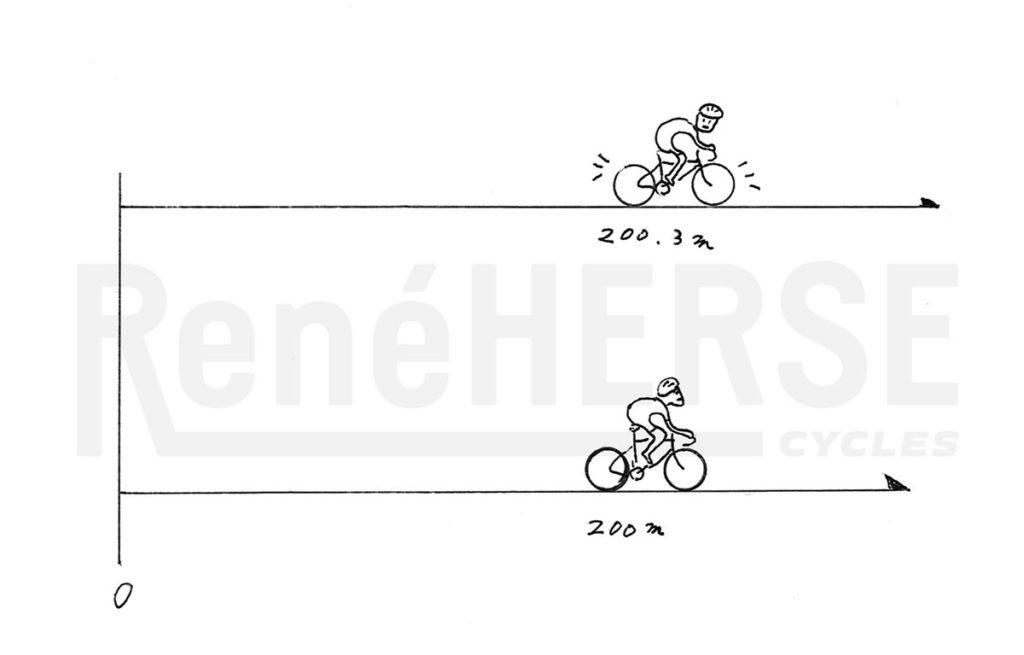
That is simple physics and easy to calculate. In fact, we did this for our book ‘The All-Road Bike Revolution.’ We ran a model with two top-level sprinters (think Peter Sagan and Sam Bennett), who put out 1600 Watts each. They sprint side-by-side, one on the superlight wheels (like the OPEN), the other on heavy wheels with wide tires (+530 g, think Firefly with 54 mm tires). After 200 meters, the sprinter on the light wheels will be just 1 foot or 30 centimeters ahead on the lighter wheels. That’s just 0.1%. In cycling terms: half a wheel length.
For a pro sprinter, half a wheel can make the difference between winning or second place. For the rest of us, the difference isn’t noticeable even in all-out sprints. Other factors will mask the 0.1% difference in speed.
So we’ve established that converting the Firefly from all-road to racing bike hasn’t made it any faster. Narrow tires and even a pound off the wheels and another off the frame (removing the full bottle) hasn’t really affect its speed. And yet we all know some bikes are faster than others. So what’s the secret? What makes a bike fast?
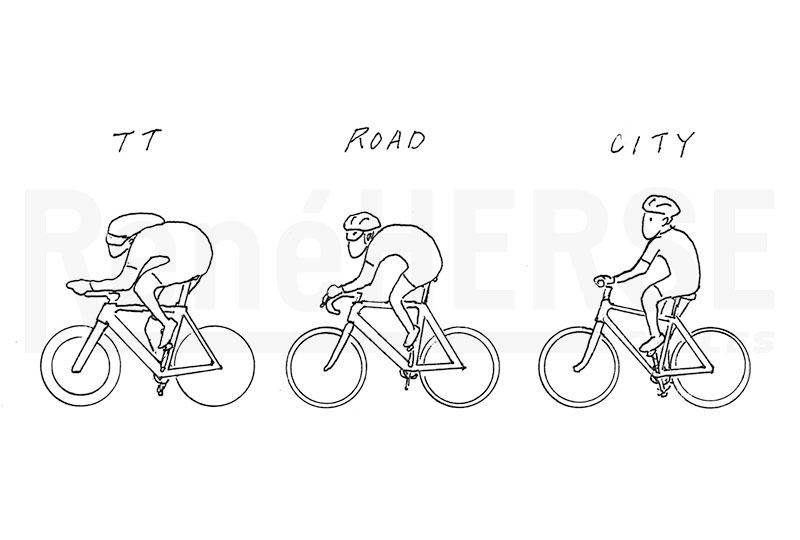
Aerodynamics
At high speeds, aerodynamics are the main resistance that a rider has to overcome. As with weight, the main component for aerodynamics is the rider. A lower and narrower position decreases the rider’s wind resistance significantly. Clothes that flap in the wind increase the wind resistance noticeably.
That’s why aerobars are so effective: They lower the rider and pull their arms inward, reducing the frontal area in two ways. Position is always a compromise, though: If you are too low and narrow to be comfortable, you put out less power and go slower than you would with a slightly less aero, but more comfortable, position.
For our Firefly vs. OPEN test, we set up both bikes with identical riding positions. The only difference was that the OPEN’s handlebars were a little wider (45.5 vs 42 cm). When both bikes were equipped with 30-32 mm tires, the Firefly coasted slightly faster on a moderate downhill, no matter whether Mark or I were riding it. With the wider 54 mm tires on the Firefly, both bikes coasted at the same speed. In other words, 24 mm wider tires had the same effect as 3.5 cm wider bars…
That doesn’t mean that wider tires are always less aero: In a different test, we found that wider tires don’t increase the wind resistance, as long as they are not wider than the bike’s down tube. We ran tires between 28 mm and 44 mm wide tires in a carefully controlled roll-down test (zero wind, constant temperature, multiple repeats). The conclusion: On the bike we used in that test (Salsa Warbird), 44 mm tires are as aero as 28 mm rubber.
What about aero wheels?
Aero wheels are a popular upgrade to improve a bike’s performance. In wind tunnel tests, they improve the aerodynamics of the bike and rider by about 2-3%. Is the difference noticeable on the road?
The OPEN has 24 spokes and aerodynamic rims, while the Firefly has 28 spokes and rims that aren’t especially aero. Yet on the downhill, the OPEN coasted slower than the Firefly, when both were equipped with similar tires (30-32 mm wide). As mentioned before, that was probably due to the wider handlebars. If the more aerodynamic wheels of the OPEN offered an advantage, it was small – too small to make up for the extra wind resistance caused by the slightly wider handlebars. Once again, the rider was more important for aerodynamics than the bike. (The wide handlebars are un-aero because they increase the frontal area of the rider.)
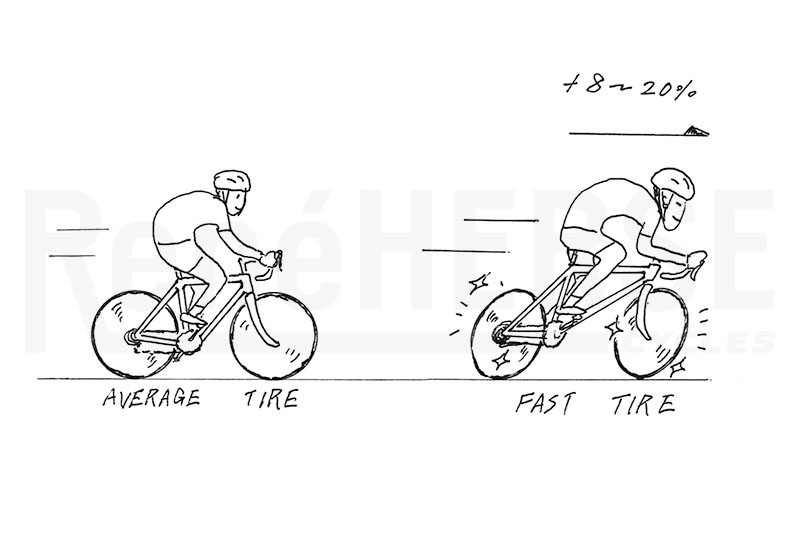
Tire Casing
We’ve seen that wide tires roll as fast as narrow ones, but that doesn’t mean that all tires offer equal performance. What makes a tire fast is first and foremost the construction of its casing. A supple casing has fine threads and as little rubber coating on the fabric as possible. The tire deforms at the bottom of the wheel, where it touches the road. This takes energy (hysteretic loss). Supple tires are easier to flex, so they lose less energy and roll faster. That isn’t the only benefit of supple tires: They also reduce vibrations that absorb energy and slow you down (suspension loss). So you gain twice with supple tires. And thanks to the reduced vibrations, your bike is more comfortable, too.
The casing is far more important than rubber compound (which matters in the lab and on steel drums, but not on the road), pressure (which makes no real difference on real roads), or tread pattern (unless you have small knobs that flex and squirm).
After rider position and clothing, tires offer the biggest gains in performance. At moderately high speeds of 30 km/h (19 mph), the difference between a slow and a fast ‘racing’ tire can amount to 8% in the rider’s speed – on the fast tire, you’ll go 2.4 km/h (1.5 mph) faster with the same effort.
If you compare supple performance tires with heavy touring or ‘gravel’ tires, the speed difference can be up to 20%. Putting that into perspective, it’s 10x as much as the benefit of aero wheels.
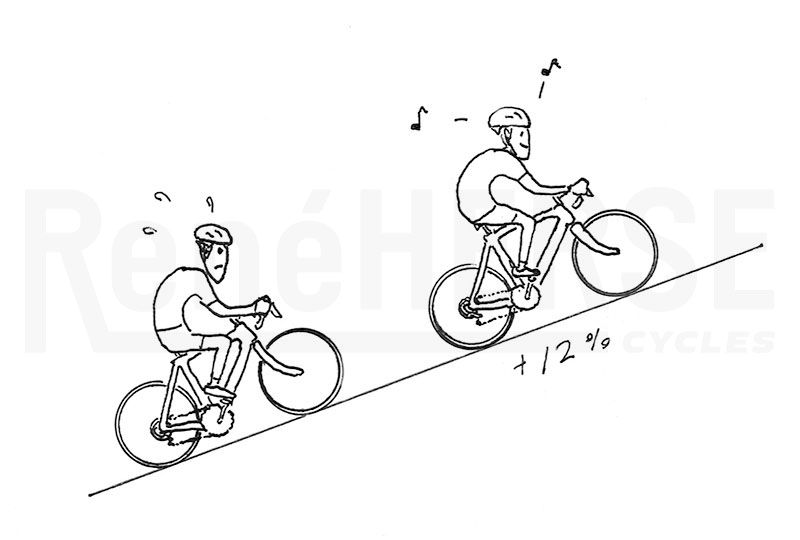
Improve the rider’s power output
Everybody knows: The best way to make a bike faster is to increase the rider’s power output. A bigger engine makes any bike go faster. That is why we train… but there’s more to it. The rider’s power output isn’t constant – it depends on the bike.
Imagine jumping on a trampoline. Then jump on a concrete floor. Then in a foam pit. It’s obvious that you’ll jump higher on the trampoline, even though your legs aren’t any stronger. The trampoline has just the right amount of flex, whereas the concrete floor is too stiff to optimize your leg power, and the foam pit is too soft. The same principle applies to bike frames: Just the right amount of flex in just the right places allows the rider to put out more power. Years ago, Bicycle Quarterly did a double-blind test of three bikes that were identical, except the frame flex was different. The difference in power on the bike that worked best for our testers was a whopping 12%. That’s huge!
You may have heard that stiffer frames are more efficient in transmitting power. Or that frame flex loses energy. But that’s not how it works. Despite many studies about bike performance and frame stiffness, none have shown that any power is lost when the frame flexes. Like a spring (or a trampoline), the frame stores energy and returns it to the drivetrain when the flex is released. The frame should be built to time the release so it helps the rider’s legs (like a trampoline), rather than work against them (like a foam pit).
The frames of racing bikes have been designed through trial-and-error to have just the right amount of flex. Superlight frames use less material, so they’re actually less stiff than cheaper bikes. Yet they seem to perform better for most riders – even in the flat races, where small weight differences matter even less than in the mountains. Fine-tuning the frame individually for its rider can provide additional benefits. Japanese Keirin racers—some of the strongest sprinters in the world—firmly believe that the hardest part of making a good bike is to tune the flex to the rider’s power output and riding style.
In fact, our testing did show some performance differences between the Firefly and the OPEN during sustained climbing. That is why we did all this testing—we wanted to find out why one bike was faster under moderately high power outputs. We’ve established that it’s not the weight, nor the tires, nor the aerodynamics. The performance differences appear to be due to different frame flex characteristics of each frame.
What about ceramic bearings or other ‘marginal gains’?
The logic is simple: If you cut a little resistance in many places, it’ll add up. Ceramic bearings may save only a watt or two, but that’s better than nothing. A better chain lube might gain another watt… I’m sure it works that way, and there’s no reason why parts should have more resistance than necessary. But don’t expect big gains, because the reality is that even cheap bearings have almost zero resistance. There’s nothing wrong with seeking these ‘marginal gains,’ but it makes sense to focus first on areas where you can get much bigger results.
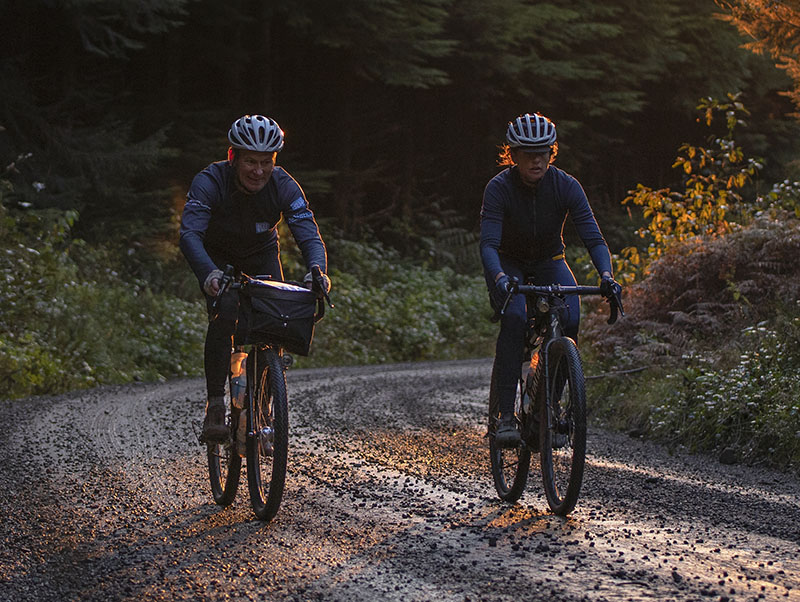
Summary
Racing bikes really are fast, but it isn’t because of their narrow tires. Good racing bikes are fast because they use supple high-performance tires. Their frames flex just the right amount for a powerful rider. The rider has little wind resistance thanks to a low riding position, narrow handlebars, and tight-fitting clothing.
All these features can be obtained from an all-road bike, too. As the Firefly shows, as long as the tires have supple casings—all tires in our test used the same Rene Herse Extralight casing—even 54 mm-wide tires roll and accelerate as fast as narrow rubber. If you set up the all-road bike with the same riding position as a racing bike, it’ll be as aerodynamic. (At least until the tires get wider than the frame.) As long as the frame flexes just right, the all-road bike will be as fast as the racer.
On the other hand, if you set up a gravel bike with wider handlebars, a more upright position and stiff, reinforced tires, it’ll be slower than a racing bike. It’s easy to blame the wide tires for that lack of speed, but just putting narrow tires on that bike won’t make it any faster. In the end, the fastest bikes use the elements of racing bikes—supple tires, aero riding position, a frame with flex in the right places—but their tires don’t need to be narrow.
And that—the ability to run wide tires without giving up speed—has opened up a whole new world of riding, since we can now enjoy the performance of a ‘fast’ bike on rough backroads, on gravel and beyond.
One test alone isn’t really enough, and this isn’t the only test we’ve done. Comparing the Firefly and the OPEN only confirms more than a decade of research into bicycle performance, handling, comfort, reliability, etc.
If you’re curious about how bikes work, you’ll enjoy our book ‘The All-Road Bike Revolution.’ In easy-to-understand terms, the book explains aerodynamics, tires, geometry, how your power output determines your position on the bike and much more. Find out what matters for speed, comfort and reliability, and enjoy the fun illustrations by Miyoshi.
For the full test of the OPEN MIN.D., as well as the roll-down tests of 28 and 44 mm-wide tires, check out the Bicycle Quarterly 74.
Image credits: Miyoshi (No. 6, 7, 9, 10); Rugile Kaladyte (No. 11).


